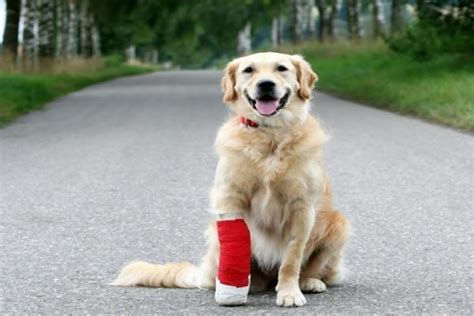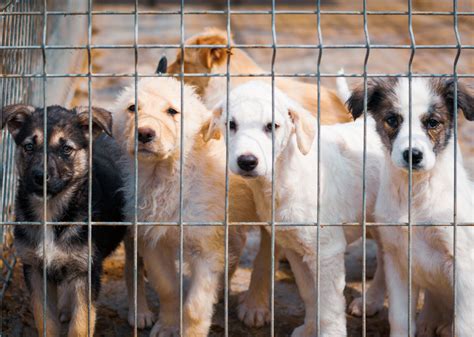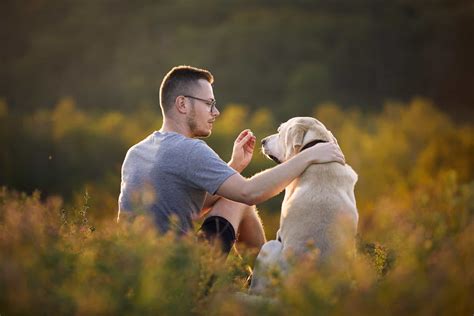Have you ever yearned to make a difference in the life of a furry friend in need, but felt overwhelmed by the apparent complexities of the process? Look no further! This article unveils a simple, straightforward approach to fulfilling your altruistic aspirations and providing assistance to a dog in distress.
Embrace the seamless journey towards lending a helping hand to an injured or suffering pup. With these easy-to-follow strategies, you'll be equipped with the knowledge and tools necessary to make a significant impact and improve the well-being of a beloved canine companion.
Embedded within this article lies a wealth of valuable insights and tips to help you navigate through the obstacles that may arise during your noble quest. Explore the art of effortlessly accommodating the needs of a hurt dog, as you embark on a journey of compassion and empathy, without breaking a sweat.
Prepare yourself to become an advocate for these voiceless creatures, documenting each step of your transformative journey. Delve into the profound world of canine care, learning how to provide comfort, security, and affection with minimal effort but profound effectiveness. Unlock the power within yourself to contribute positively to the welfare of a dog in need, as you discover the secrets of effortless assistance.
Bringing Hope to an Injured Canine: 8 Simple Steps to Make a Difference

In this section, we will explore eight effortless ways you can contribute to the well-being of a wounded dog and bring a sense of hope to their life. By following these steps, you have the opportunity to positively impact their journey towards recovery without exerting excessive effort.
- Extend a Helping Hand: Commence your mission by offering a helping hand to the injured dog. Approach them with care and gentleness, making sure to avoid any sudden movements that may cause them further distress. This initial gesture will convey your compassion and readiness to assist.
- Prioritize Professional Assistance: Seek professional veterinary assistance as soon as possible. The expertise of a veterinarian is crucial to evaluate the dog's injuries accurately. By prioritizing professional care, you ensure their well-being and increase the chances of a successful recovery.
- Provide Comfort and Shelter: Create a safe and comforting environment for the injured dog. Prepare a cozy space with soft bedding and appropriate temperature control. This will help alleviate their discomfort and promote a sense of security during their recovery.
- Ensure Proper Nutrition: Optimize the dog's recovery process by providing a nutritious and balanced diet. Consult with a veterinarian to determine the appropriate food and feeding schedule suitable for their specific needs. Adequate nutrition is essential for their physical healing and overall well-being.
- Administer Medication and Treatments: Follow the prescribed medication and treatment plan provided by the veterinarian. It is essential to adhere to the instructions diligently to maximize the positive impact on the dog's healing process. Avoid skipping doses and monitor their response closely.
- Engage in Gentle Exercise and Rehabilitation: As the dog's condition improves, introduce gentle exercises and rehabilitation activities. Consult with a veterinarian or a professional canine therapist to develop a suitable exercise plan that aids in their physical recovery and improves their mobility.
- Foster Emotional Support and Bonding: Emotional support plays a vital role in the healing journey of an injured dog. Spend quality time with the dog, offering gentle affection and reassurance. Building a bond based on trust and care will contribute to their emotional well-being and overall recovery.
- Spread Awareness and Encourage Adoption: Utilize social media platforms, local communities, and animal welfare organizations to raise awareness about the plight of injured dogs. Advocate for their rescue, rehabilitation, and adoption, inspiring others to make a difference in the lives of these vulnerable animals.
By following these eight simple steps, you can bring hope and make a significant difference in the life of an injured canine. Remember, even the smallest acts of kindness can have a profound impact on their recovery and overall well-being.
Understanding the Significance of Offering Assistance
Comprehending the value of extending a helping hand is essential in making a positive impact on the lives of those in need. It involves recognizing the significance of providing support and aid to individuals or creatures facing difficult situations. By gaining a deeper understanding of the importance of offering assistance, we can contribute towards creating a better and more compassionate world.
- Recognizing the power of empathy in helping others
- Understanding the transformative effect of assistance on individuals
- Promoting a sense of community and connection through acts of help
- Appreciating the ripple effect that assistance can have on society
- Encouraging kindness and compassion towards those in need
Empathy plays a crucial role in comprehending the importance of extending a helping hand. It involves putting ourselves in someone else's shoes and understanding their challenges, pain, or suffering. By empathizing, we develop a deeper connection with those in need, allowing us to provide targeted assistance that addresses their unique circumstances. Through offering support, we can transform lives and empower individuals to overcome their difficulties and move towards a brighter future.
Moreover, providing assistance not only benefits the recipients but also contributes to the overall well-being of the community. Acts of help not only alleviate immediate problems but also create a sense of unity and connection among individuals. By offering support, we foster a culture of compassion and kindness, inspiring others to follow suit and contribute towards the betterment of society as a whole.
The impact of assistance goes beyond the immediate beneficiaries, as it can trigger a ripple effect within society. When individuals experience the positive effects of help, they are more likely to extend support to others, creating a domino effect of kindness. This interconnectedness amplifies the impact of individual actions and promotes a more caring and inclusive society.
In conclusion, understanding the significance of offering assistance entails recognizing the power of empathy, acknowledging the transformative effect of help, fostering community and connection, appreciating the ripple effect in society, and encouraging kindness and compassion. By embracing the importance of extending a helping hand, we can make a meaningful difference in the lives of others and work towards building a more empathetic and supportive world.
Exploring Local Animal Shelters and Rescues

Discovering and researching nearby animal shelters and rescues is a crucial step in your journey to provide assistance to injured canines. By exploring the various organizations and establishments that focus on the welfare of animals, you pave the way to finding the perfect avenue to make a difference. Understanding the significance of these facilities and the unique services they provide is essential in ensuring your efforts align with their goals and requirements.
| Shelter/Rescue Name | Location | Contact Information | Services Offered |
|---|---|---|---|
| Compassionate Canines Shelter | City A | Phone: 123-456-7890 Email: [email protected] | Emergency medical care, rehabilitation, adoption services, community outreach programs |
| Pawsitive Paws Rescue | City B | Phone: 987-654-3210 Email: [email protected] | Rescue and rehoming abandoned dogs, behavior training, spaying/neutering, vaccination |
| Caring Hearts Animal Sanctuary | City C | Phone: 555-123-4567 Email: [email protected] | Senior dog care, hospice care, fostering programs, animal therapy |
By researching local animal shelters and rescues, you gain insights into their missions, areas of focus, and the specific support they provide to injured dogs. This information empowers you to make informed decisions and take meaningful steps towards achieving your goal. Additionally, reaching out to these organizations allows you to establish a network of like-minded individuals and expand your knowledge about the local animal welfare community. This collaborative approach will not only facilitate your efforts to help hurt dogs but also create a lasting impact within your community.
Learning the Essentials of Canine First Aid
Diving into the realm of dog first aid is a crucial step towards becoming a knowledgeable and skilled caregiver for your furry friend. By understanding the fundamentals of canine first aid, you can effectively respond to various emergency situations and provide immediate assistance to your dog in times of need.
One of the primary aspects of learning about dog first aid is recognizing the indications of distress or injury in your pet. Whether it's detecting abnormal behavior, changes in appetite, or physical symptoms, being observant can help you identify potential emergencies early on.
Equally important is knowing how to administer basic first aid techniques to stabilize your furry companion's condition. This includes understanding how to properly clean and dress wounds, safely remove foreign objects, and apply compression to stop bleeding.
- Discovering the importance of establishing a canine first aid kit that includes essential supplies such as gauze, adhesive tape, antiseptic solution, and a digital thermometer is crucial.
- Learning techniques for immobilizing injuries, such as creating splints or using bandages, can help prevent further damage and reduce pain for your dog.
- Understanding the steps to perform cardiopulmonary resuscitation (CPR) on dogs can be life-saving in critical situations.
- Gaining knowledge about common toxins and poisons for dogs can aid in preventing accidental ingestion and swiftly responding to poisoning incidents.
Additionally, familiarizing yourself with emergency contact numbers for veterinary clinics or animal poison control centers can ensure immediate access to professional assistance when needed.
In conclusion, obtaining a solid understanding of dog first aid is indispensable for any dog owner or enthusiast. By committing to learning and practicing these essential skills, you can effectively protect the well-being of your canine companion, offering them the best chance for a swift and successful recovery in times of distress or injury.
Creating a Secure and Cozy Environment

Ensuring the wellbeing of an injured canine companion requires the establishment of a safe and comfortable living space. By setting up a secure environment, you can provide the necessary protection and peace of mind for your furry friend's recovery.
To begin, consider designating a designated area for your dog to rest and recuperate, away from high traffic areas and potential hazards. This space should be equipped with soft bedding and cushions to provide a comfortable place for your dog to relax.
- Use pet gates or barriers to prevent your dog from accessing stairs, slippery surfaces, or areas where they might accidentally injure themselves further.
- Remove any objects that could be potential hazards, such as sharp edges, toxic plants, or small items that could be swallowed.
- Ensure that the space is well-ventilated and at a comfortable temperature, avoiding drafts or excessive heat that could exacerbate your dog's condition.
In addition to creating a physical environment, it is important to foster a calm and peaceful atmosphere. Minimize loud noises and commotion in the vicinity to reduce stress for your injured dog.
Remember to consult with a veterinarian for specific recommendations tailored to your dog's individual needs and injuries. Following these guidelines will help you create a safe and comforting environment that promotes a smooth recovery process for your beloved furry friend.
Ensuring Proper Nutrition and Hydration for Rehabilitating Canine Companions
Meeting the fundamental needs of a recovering four-legged friend involves providing them with the essential elements that promote their overall well-being. This segment aims to highlight the importance of offering adequate nourishment and hydration to help them regain their health and vitality. Without compromising on quality or quantity, a balanced diet and proper hydration can work wonders in restoring their strength and providing them with the fuel they need to heal.
Nutrition: Fuel for Recovery
Ensuring your furry companion receives a nutritionally rich diet can play a crucial role in their rehabilitation journey. Opting for high-quality, easily digestible food that suits their specific dietary requirements can help in boosting their immune system, supporting their body's healing processes, and preventing any potential complications. Whether it's utilizing commercially available dog food or preparing home-cooked meals, it is important to consult a veterinary professional to determine the most suitable diet plan for your four-legged friend.
Hydration: Essential for Healing
Proper hydration is just as important as providing nutritional sustenance during a dog's recovery. Adequate hydration helps regulate body temperature, aids digestion, and promotes healthy organ function. Ensuring your loyal companion always has access to fresh, clean water can significantly contribute to their overall wellness. Additionally, incorporating wet food or offering diluted broths can further enhance their hydration levels.
The Importance of Consistency and Balance
Consistency and balance are key when it comes to providing proper nutrition and hydration. Establishing a routine for meals and offering regular access to water can help your canine friend feel secure and content during their recovery period. Ensuring meals are served at regular intervals and monitoring their food and water intake can also help address any potential appetite issues or unusual consumption patterns that may indicate a need for further attention.
Consulting with a Professional
Every dog's nutritional needs may vary depending on factors such as age, size, and medical history. Seeking guidance from a qualified veterinarian or animal nutritionist can further assist in establishing a tailored nutrition and hydration plan for your furry friend's specific requirements. These professionals can assess their current health status, identify any potential deficiencies, and recommend appropriate dietary supplements if necessary.
By prioritizing proper nutrition and hydration, you can actively contribute to the well-being and recovery of your companion in need. Remember, a well-fed and hydrated dog stands a better chance of bouncing back to their playful and vibrant selves sooner, bringing you both joy and a sense of fulfillment.
Gaining Trust and Establishing a Connection with the Injured Canine Companion

When it comes to providing support and aid to an injured dog, establishing trust and forming a strong bond are crucial elements of the rehabilitation process. In this section, we will explore various strategies and approaches that can help you gain the trust of the hurting canine effortlessly, leading to a deeper connection between you and the dog.
Building trust with a traumatized dog requires patience, consistency, and sensitivity. One of the key ways to achieve this is through positive reinforcement. By using rewards and praise, you can encourage the dog to associate your presence and actions with pleasant experiences, gradually building trust and confidence.
| Effective Techniques for Gaining Trust and Building a Bond |
|---|
| 1. Respect Boundaries |
| 2. Active Listening |
| 3. Calm Energy |
| 4. Consistency and Routine |
| 5. Socialization |
| 6. Non-threatening Body Language |
| 7. Building Confidence through Training |
| 8. Bonding Activities |
Respecting the dog's boundaries is vital during the trust-building process. It is essential to allow the dog to approach at their own pace and give them the space they need to feel comfortable. This helps to establish a sense of safety and security in their environment.
Active listening, both through observing the dog's body language and responding to their needs, is another important aspect of building trust. By paying attention to their signals, you can better understand their emotional state and respond accordingly, showing them that you are attentive and caring.
In addition, maintaining a calm energy is beneficial in establishing trust, as any signs of anxiety or stress can be sensed by the dog. By remaining composed and projecting a sense of inner calm, you convey a reassuring presence to them.
Creating a consistent and predictable routine is also helpful for a dog's trust-building process. By providing regular meals, exercise, and affection, you can establish a sense of stability and reliability, enabling the dog to feel secure in their interactions with you.
Socialization is another essential aspect of building a bond with a hurt dog. Introducing them to positive and controlled interactions with other animals and people can help them develop social skills and confidence. This fosters a sense of belonging and trust in different environments.
Non-threatening body language is imperative when establishing trust. Avoid making sudden movements, direct eye contact, or invading the dog's personal space, as these can be perceived as threatening behaviors. Instead, use gentle and relaxed body language to signal your friendly intentions.
Training sessions not only serve as a means to teach the dog essential commands but also as an opportunity to strengthen the bond between you. Through positive reinforcement training techniques, you can provide mental stimulation, build confidence, and deepen the trust the dog has in you.
Lastly, engaging in bonding activities such as walks, playtime, and grooming sessions can create positive associations and strengthen the emotional bond. These activities provide opportunities for you to connect with the dog on a deeper level and show them love and care.
By employing these techniques and approaches, you will be well on your way to gaining the trust and building a strong bond with the injured dog, setting the foundation for their recovery and a fulfilling relationship.
Seeking Professional Assistance and Veterinary Care
When it comes to supporting a distressed canine, it is vital to seek professional help and medical attention from a qualified veterinarian. This step plays a crucial role in ensuring the overall well-being and recovery of the injured dog. Professionals possess the expertise and experience necessary to accurately diagnose the dog's condition and provide effective treatment options.
Consulting a veterinarian offers several advantages when assisting an ailing dog. Firstly, these professionals possess a deep understanding of animal behavior and can effectively communicate with the dog to assess its condition. They are skilled at recognizing signs of distress and can administer appropriate care to alleviate pain and discomfort.
Moreover, veterinarians employ specialized tools and technologies to conduct thorough examinations and diagnostic tests. These assessments allow them to identify the root cause of the dog's injury and determine the most suitable treatment plan. Additionally, veterinary clinics are equipped with medications and medical supplies that may be necessary in providing immediate relief to the injured dog.
Seeking professional help is particularly important when dealing with complex injuries or conditions that require specialized care. Veterinarians have comprehensive knowledge of various surgical procedures and can perform operations if required. Their expertise minimizes the risk of further complications and ensures the dog receives the best possible care and treatment.
In summary, seeking professional assistance and veterinary care is essential for helping an injured dog. Veterinarians possess the expertise, knowledge, and resources necessary to accurately diagnose the dog's condition and provide appropriate treatment. By trusting professionals with the task, one can ensure the well-being and recovery of the hurt dog in the most effective and efficient manner.
Sharing Inspiring Tales of Triumph and Motivating Others to Take Action

Within the realm of realizing aspirations, there lies a powerful and captivating means to ignite the spark of transformation in others. By sharing success stories, we can kindle a sense of belief and inspire individuals from all walks of life to take action. As we recount extraordinary accomplishments and fortuitous encounters, we foster a collective empathy that compels us to act for the betterment of those in need.
The Power of Shared Success Stories
Success stories have an innate ability to touch the core of our beings. They resonate deep within and captivate our imaginations, reminding us of the extraordinary possibilities that lie waiting to be discovered. These tales of triumph, filled with determination, resilience, and unwavering commitment, have the power to shape perspectives and change lives. Through narratives of individuals who have turned adversity into triumph, we learn that even the smallest actions can have a profound impact.
Sharing stories of compassion and resilience can motivate others to overcome their own hurdles and find the courage to make a difference.
Inspiring Others to Take Action
By sharing stories that highlight the potential for change and the rewards of compassion, we motivate others to harness their own power to make a difference. These tales of empowerment serve as calls to action, inspiring individuals to step outside their comfort zones and contribute positively to their communities. They remind us that each person possesses the ability to enact change, no matter how big or small, and that our collective efforts can create a ripple effect of transformation.
By inspiring others to act, we create a community of like-minded individuals working towards a common goal: to alleviate suffering and create a more compassionate world.
Through sharing success stories and inspiring others to act, we cultivate a profound sense of empathy and motivate individuals to make tangible changes in the lives of those in need. Each story holds the power to galvanize action, spark change, and create a domino effect of kindness and compassion. Let us embrace the opportunity to share these tales of triumph, finding strength in unity and inspiring others to join in the pursuit of making a difference.
FAQ
How can I fulfill my dream of helping a hurt dog?
You can fulfill your dream of helping a hurt dog by volunteering at a local animal shelter, fostering a dog in need, or making a donation to a dog rescue organization.
What are some ways to effortlessly help a hurt dog?
You can effortlessly help a hurt dog by spreading awareness about the importance of adopting rescue dogs and by sharing information about dogs in need of a home through social media.
Is it possible to help a hurt dog without spending a lot of money?
Yes, it is possible to help a hurt dog without spending a lot of money. You can donate your time by walking shelter dogs, fostering a dog, or even just raising awareness about the issue.
What steps should I take if I find a hurt dog on the street?
If you find a hurt dog on the street, it's important to approach with caution and not scare or startle the dog. You should call your local animal control or animal rescue to report the situation and let them handle the rescue and medical care for the dog.
Are there any online platforms where I can find hurt dogs to help?
Yes, there are online platforms such as pet adoption websites and social media groups dedicated to helping hurt dogs find homes. You can browse through these platforms to find a dog in need of your help.
What steps can I take to help a hurt dog effectively?
There are several steps you can take to effectively help a hurt dog. First, make sure to assess the situation and determine if the dog needs immediate medical attention. If so, contact a veterinarian or an animal hospital right away. If the situation is not critical, you can provide basic first aid like cleaning and bandaging wounds or splinting fractures. Additionally, you should try to provide a comfortable and safe environment for the dog while waiting for professional help.
Is it possible to help a hurt dog without any professional knowledge or training?
Yes, it is possible to help a hurt dog even without professional knowledge or training. While it is always recommended to seek professional help, there are still actions you can take to make a difference. For instance, you can try to approach the dog calmly and gently, creating a trusting and non-threatening environment. Providing food, water, and shelter can also aid in the dog's recovery. However, it's important to remember that professional intervention is always the best option, especially for serious injuries.



